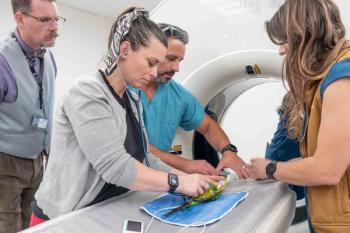
Tweaking your radiograph interpretation for digital radiography-abdomen (Proceedings)
Over the last few years digital radiography has become "the purchase" for veterinary clinics and hospitals. While the impetus for the purchase may at first be to keep up with the Jones', those who have made the switch quickly realize the benefits of "going digital".
Over the last few years digital radiography has become "the purchase" for veterinary clinics and hospitals. While the impetus for the purchase may at first be to keep up with the Jones', those who have made the switch quickly realize the benefits of "going digital". However switching to digital does have its downsides but thankfully those downsides are temporary and mostly involve a re-education of the staff and veterinarians.
For veterinarians, correct assessment of a digital radiograph requires letting go of analog film interpretative biases that have developed throughout your career. One of the tough biases to let go of is the tactile response. Most likely veterinarians who made the switch from analog to digital found themselves reaching for the screen at some point as if to hold the screen like a sheet of film. And while this is one of those "duh" moments that makes everyone laugh it points out how ingrained certain habits become through repetition. But don't worry you are not alone. There are several common interpretative over reads associated with the transition from analog to digital. Below is a list of the most common interpretative mistakes when veterinarians switch from analog to digital radiography.
Peritoneal detail
Due to the inherent improved contrast resolution on digital systems abdominal contents become more prominent. On traditional radiographs enhanced visualization of abdominal structures is associated with free abdominal air and free abdominal air is a surgical emergency. The enhanced peritoneal detail is the norm for digital radiography and requires an interpretative adjustment. Typically this "resetting" or recalibration of the abdominal detail in a normal digital abdomen takes a few weeks.
Ascites
Identifying "wisps" on radiographs is typically associated with the presence of ascites or peritoneal inflammation. Again due to digital's improved contrast resolution "wisps" can be better visualized in the peritoneal space allowing identification of free fluid or peritoneal inflammation that may have gone unnoticed on analog radiographs. The "resetting" of the normal abdominal detail typically requires 2 weeks to 1 month of film review.
Liposplenomass
Digital radiographs of fat cat abdomens has revealed an unexpected finding of artifactual splenomegaly. On the V/D radiographs there is a high incidence of a visible structure along the left lateral peritoneal cavity. Based on the appearance and location a logical conclusion of splenomegaly would be made. However this opacity does not persist on the lateral view making splenomegaly unlikely. Ultrasonographic evaluation of this region has consistently revealed fat accumulation in this region.
Superimposed structures
Again the enhanced contrast resolution of digital radiographs can cause interpretative issues early on. Skin masses are extremely prominent due to the contrast between the mass and the surrounding air and masses that previously only had this appearance when they were in the lung can now reside on the skin and give the mistaken impression of being pulmonary. Orthogonal views and placing barium on skin masses becomes very important with digital radiography.
Pelvic fat
Once again enhanced contrast resolution of digital radiographs can result in a pronounced appearance to fat. On the lateral projection of a fat cat abdomen the pelvic fat is visualized as a radiolucent region within the kidney center. Veterinarians unfamiliar with this finding could erroneously conclude that pathology is present. This interpretative error can be easily overcome based on location and appearance of this finding.
The visible pancreas
Visualization of the left pancreatic limb in obese cats is a frequent occurrence with digital radiographs. Visualization alone of this limb does not indicate pathology however loss of abdominal detail in this region is more typical of pancreatitis or peripancreatic mesenteric inflammation.
Retroperitoneal structures and fluid
Fat in the retroperitoneal space enhances the normal soft tissue anatomy on digital radiographs. The kidneys, iliopsoas musculature and caudal circumflex iliac artery are all well visualized in obese cats and dogs. The caudal circumflex iliac artery can be particularly troubling when identified since it is not visible in all cases and typically only noticed when evaluating this region for suspected pathology. Knowing the normal appearance and location of the caudal circumflex iliac artery can avoid inadvertently calling this normal structure a pathologic finding. Identifying retroperitoneal fluid can also be difficult since it is an uncommon finding. Retroperitoneal fluid is most commonly identified in cases of coagulopathy, acute renal failure, foxtail migration and trauma. Recognizing wisps in the retroperitoneal space is the first indication of retroperitoneal fluid.
Superimposed structures
Again the enhanced contrast resolution of digital radiographs can cause interpretative issues early on. Skin masses are extremely prominent due to the contrast between the mass and the surrounding air Orthogonal views and placing barium on skin masses becomes very important with digital radiography.
In conclusion
The transition from analog to digital is well worth it as those who have done it before you will quickly confirm. But this transition is not without drawbacks and relearning or resetting your normal abdominal set point is a big one. Keeping in mind that the improved contrast resolution of digital results in seeing "things" that were not visible before is important. Lastly, utilizing radiology consults in the first 4-6 weeks after "going digital" may be a great way to retrain your interpretations and avoid the common interpretation mistakes associated with transitioning from analog to digital.
Newsletter
From exam room tips to practice management insights, get trusted veterinary news delivered straight to your inbox—subscribe to dvm360.






